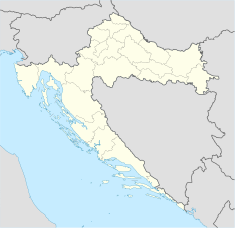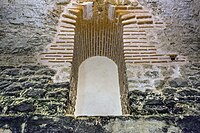
An underground city is a series of linked subterranean spaces that may provide a defensive refuge; a place for living, working or shopping; a transit system; mausolea; wine or storage cellars; cisterns or drainage channels; or several of these. Underground cities may be currently active modern creations or they may be historic including ancient sites, some of which may be all or partially open to the public.

The Dinaric Alps, also Dinarides, are a mountain range in Southern and Southcentral Europe, separating the continental Balkan Peninsula from the Adriatic Sea. They stretch from Italy in the northwest through Slovenia, Croatia, Bosnia and Herzegovina, Serbia, Montenegro, and Kosovo to Albania in the southeast.

Salona was an ancient city and the capital of the Roman province of Dalmatia. Salona is located in the modern town of Solin, next to Split, in Croatia.

Solin is a town and a suburb of Split, in Split-Dalmatia county, Croatia. It is situated right northeast of Split, on the Adriatic Sea and the river Jadro.

Diocletian's Palace is an ancient palace built for the Roman emperor Diocletian at the end of the third century AD, which today forms about half of the old town of Split, Croatia. While it is referred to as a "palace" because of its intended use as the retirement residence of Diocletian, the term can be misleading as the structure is massive and more resembles a large fortress: about half of it was for Diocletian's personal use, and the rest housed the military garrison.

Mediana is an important archeological site from the late Roman period, located in the eastern suburb of the Serbian city of Niš. It represents a luxurious residence with a highly organised economy. Excavations have revealed a villa with peristyle, thermae, granary and water tower. The residence dates to the reign of Constantine the Great 306 to 337. Although Roman artifacts can be found scattered all over the area of present-day Niš, Mediana represents the best-preserved part of Roman Naissus. In 1979, Mediana was added to the Archaeological Sites of Exceptional Importance list, protected by the Republic of Serbia.

Gregory of Nin was a Croatian Catholic prelate who served as a medieval Bishop of Nin and strongly opposed the pope and official circles of the Catholic Church. He introduced the Croatian language in the religious services after the Great Assembly in 926, according to traditional Croatian historiography. Until that time, services were held only in Latin, not being understandable to a majority of the population. Not only was this important for Croatian language and culture, but it also made Christianity stronger within the Croatian kingdom.

Stobreč is a historical village and now a tourist resort on the Adriatic Sea, in central Dalmatia, Croatia. Administratively it is part of the city of Split. Founded as Epetium, Stobreč has been settled since the classical antiquity founded as an Ancient Greek colony on the Illyrian coast.

Split ; Italian: Spalato: pronounced[ˈspalato] see other names), is the second-largest city of Croatia after the capital Zagreb, the largest city in Dalmatia and the largest city on the Croatian coast. It lies on the eastern shore of the Adriatic Sea and is spread over a central peninsula and its surroundings. An intraregional transport hub and popular tourist destination, the city is linked to the Adriatic islands and the Apennine Peninsula. More than 900,000 tourists visit Split each year.

The Cathedral of Saint Domnius, known locally as the Sveti Dujam or colloquially Sveti Duje, is the Catholic cathedral in Split, Croatia. The cathedral is the seat of the Archdiocese of Split-Makarska, currently headed by Archbishop Zdenko Križić. The Cathedral of St. Domnius is a complex of a church, formed from an Imperial Roman mausoleum, with a bell tower; strictly the church is dedicated to the Virgin Mary, and the bell tower to Saint Domnius. Together they form the Cathedral of St. Domnius.

The Aqueduct of Diocletian is an ancient Roman aqueduct near Split, Croatia constructed during the Roman Empire to supply water to the palace of the emperor Diocletian, who was Augustus 284 to 305 AD, retired to Spalatum, and died there in 311.
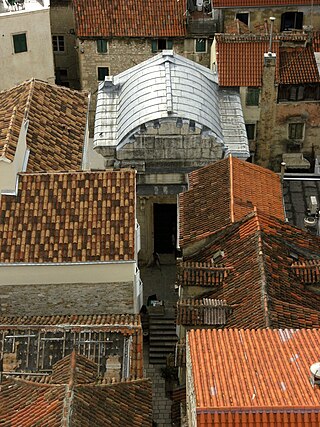
The Temple of Jupiter(Croatian: Jupiterov hram) is a temple in Split, Croatia dedicated to the Ancient Roman god Jupiter. It is located in the western part of Diocletian's Palace near the Peristyle, the central square of the imperial complex. It was built between 295 and 305, during the construction of the Palace, and was probably turned into a Baptistery of St. John the Baptist in the 6th century, at the same time when the crypt dedicated to St. Thomas was built. Before the entrance to the Temple is one of the twelve sphinxes brought from Egypt by Emperor Diocletian. Scottish architect Robert Adam considered this temple to be one of Europe's most beautiful monuments.
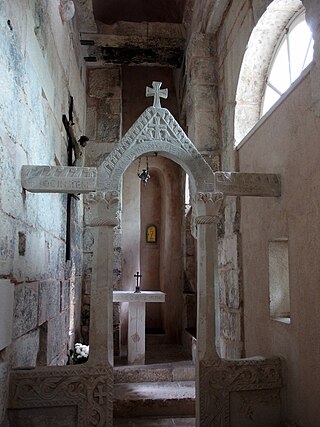
St. Martin's Church is a Roman Catholic church in Split, Croatia. Built into a small space within the ancient Golden Gate of Diocletian's northern wall, it is one of the oldest churches in the city. St. Martin's Church is one of Split's tourist attractions and is known for its fine 11th century chancel screen. It is currently in the care of the Dominican sisters, who have a monastery next door. The church itself is open to public visits.

The Golden Gate, or "the Northern Gate", is one of the four principal Roman gates into the stari grad of Split. Built as part of Diocletian's Palace, it served as the main gate through which the Emperor entered the complex and was elaborately decorated to mark its status. Over the course of the Middle Ages, the gate was sealed off and lost its columns and statuary. It was reopened and repaired in modern times and now serves as a tourist attraction.
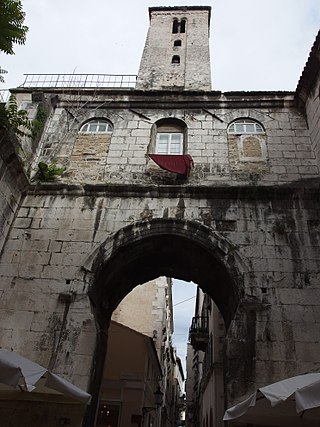
The Iron Gate, or "the Western Gate", is one of the four principal Roman gates into the stari grad of Split that was once Diocletian's Palace. Originally a military gate from which troops entered the complex, the gate is the only one to have remained in continuous use to the present day.

The Silver Gate, or "the Eastern Gate", is one of the four principal Roman gates into the stari grad of Split that was once Diocletian's Palace. The gate faces east towards the Roman town of Epetia, today Stobreč.

The Vestibule, also known as The Rotonda or The Atrium, is the first section of the imperial corridor in Diocletian's Palace that led from the Peristyle, which was once the formal entrance to the imperial apartments.

The Bronze Gate, or "the Southern Gate", is the smaller of the four principal Roman gates into the stari grad of Split. Built as part of Diocletian's Palace, it was originally a sea gate from which the Emperor entered the complex by boat. Today it is the main entry point from the promenade to the cathedral.

The Domus Tiberiana was an Imperial Roman palace in ancient Rome, located on the northwest corner of the Palatine Hill. It probably takes its name from a house built by the Emperor Tiberius, who is known to have lived on the Palatine, though no sources mention his having built a residence. It was enlarged by the successors to Tiberius, and would have been the principal Roman residence of Tiberius, Caligula, Claudius, and Nero during the early part of his reign. Relatively little is known of the structure archaeologically, since the Farnese Gardens have occupied the site of the main level since the 16th century, making excavation difficult.
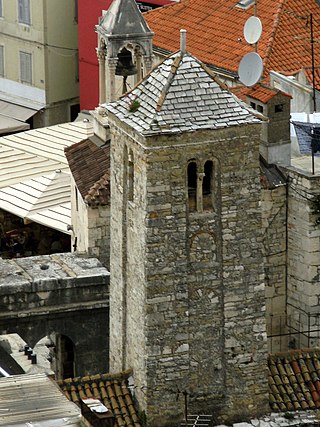
The Belltower of the Church of Our Lady of the Belfry is a disused Roman Catholic church in Split, Croatia. Built into a small space within the ancient Iron Gate of Diocletian's western wall. Today little survives of the building, apart from the belltower, one of the oldest in Croatia.

